Management Accounting Report: Financial and Cost Analysis of ABC Ltd.
VerifiedAdded on 2021/02/20
|16
|5189
|35
Report
AI Summary
This report provides a comprehensive overview of management accounting principles and practices, focusing on their application within a manufacturing company, ABC Ltd. It begins with an introduction to management accounting, defining its role in organizational planning, policy-making, and operational control, with an emphasis on the importance of both financial and non-financial data. The report then delves into the different types of management accounting systems, including inventory management, cost accounting, and job costing systems, highlighting their essential requirements and benefits, particularly within the context of ABC Ltd. Task 2 focuses on the application of marginal and absorption costing techniques, providing detailed calculations and analysis of production costs, profitability, and the preparation of budgeted profit and loss statements. The report also explores the advantages and disadvantages of various planning tools used in budgetary control, and how management accounting systems can contribute to sustainable financial success. The report concludes by summarizing key findings and providing references for further study. This report is contributed by a student to be published on the website Desklib. Desklib is a platform which provides all the necessary AI based study tools for students.
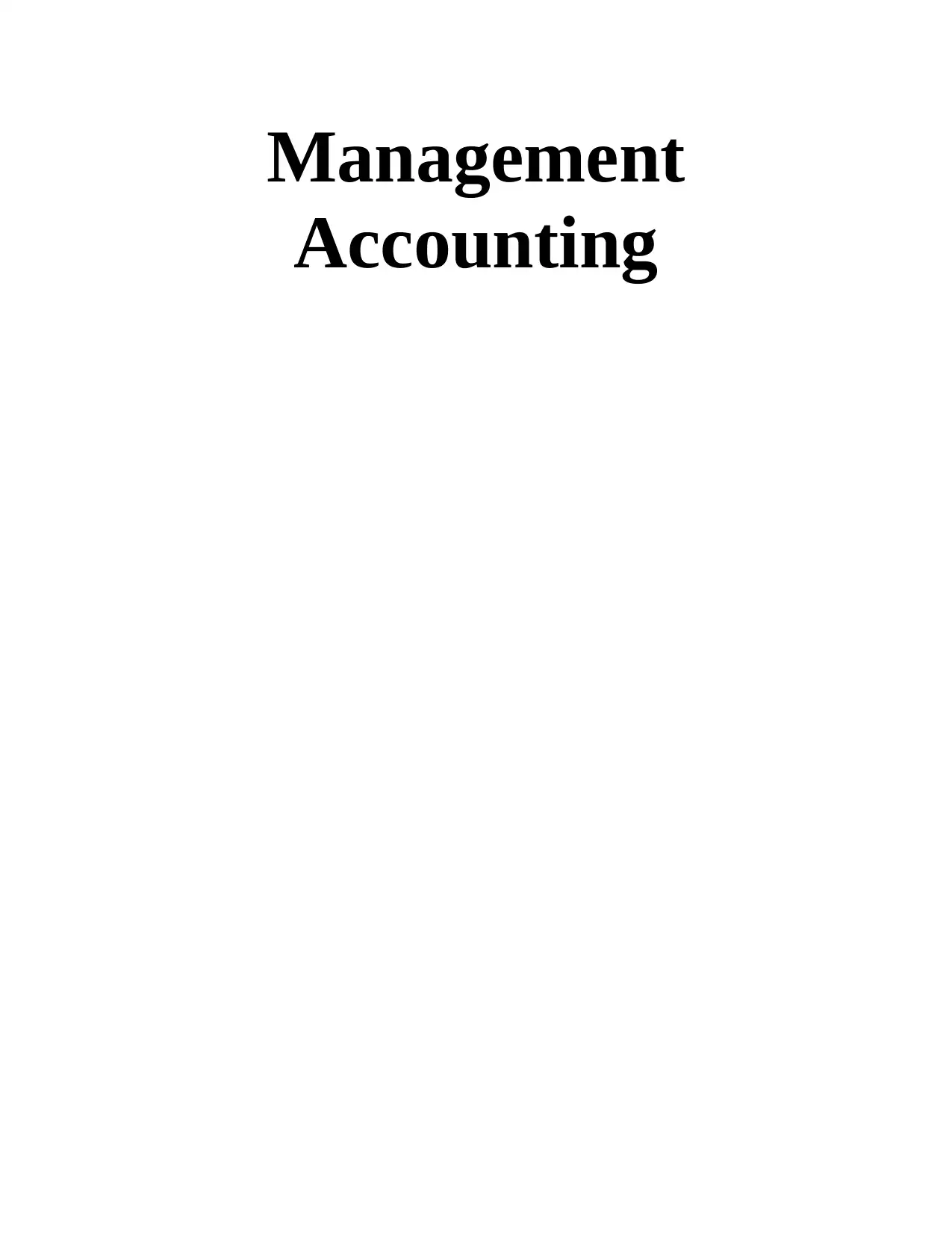
Management
Accounting
Accounting
Paraphrase This Document
Need a fresh take? Get an instant paraphrase of this document with our AI Paraphraser
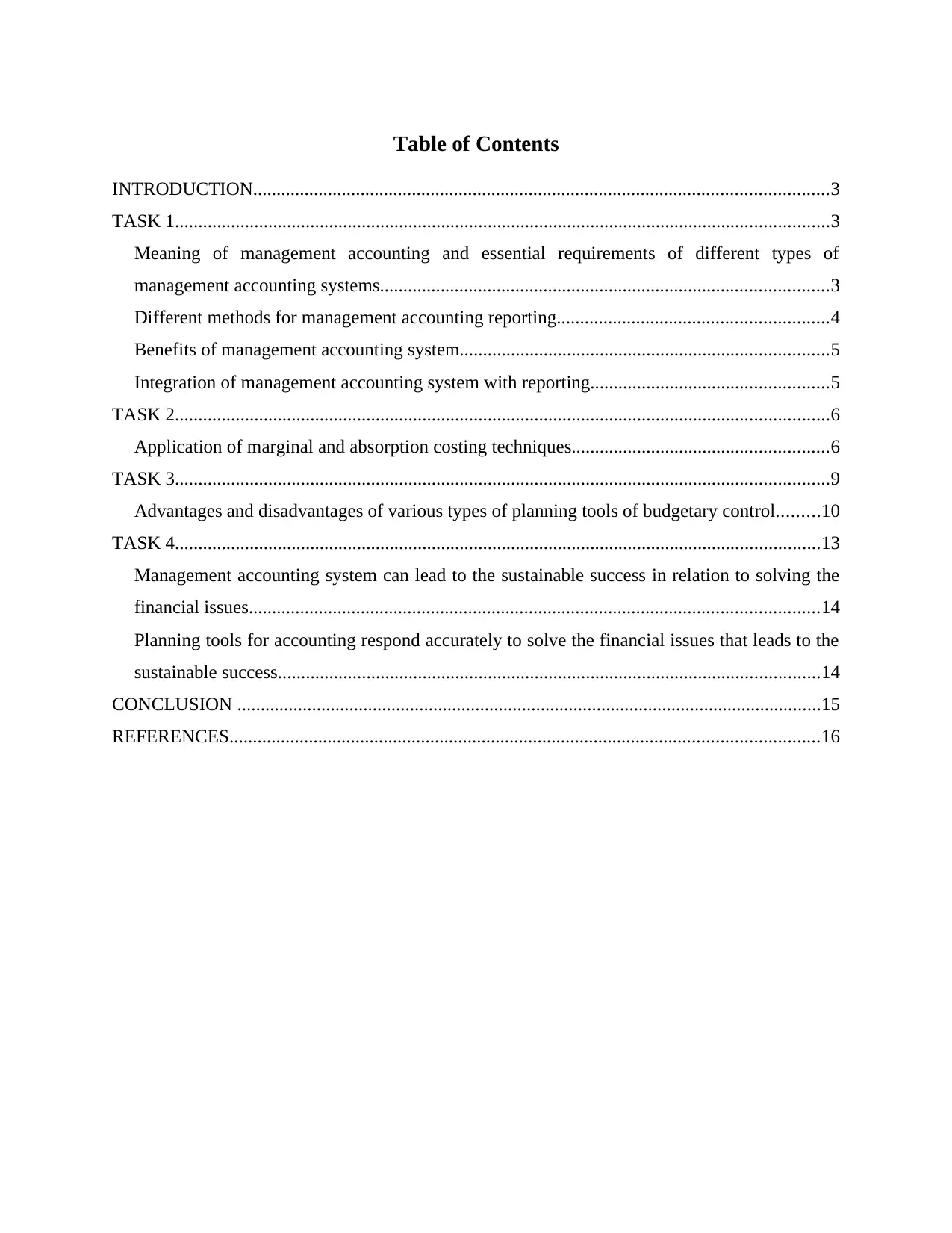
Table of Contents
INTRODUCTION...........................................................................................................................3
TASK 1............................................................................................................................................3
Meaning of management accounting and essential requirements of different types of
management accounting systems................................................................................................3
Different methods for management accounting reporting..........................................................4
Benefits of management accounting system...............................................................................5
Integration of management accounting system with reporting...................................................5
TASK 2............................................................................................................................................6
Application of marginal and absorption costing techniques.......................................................6
TASK 3............................................................................................................................................9
Advantages and disadvantages of various types of planning tools of budgetary control.........10
TASK 4..........................................................................................................................................13
Management accounting system can lead to the sustainable success in relation to solving the
financial issues..........................................................................................................................14
Planning tools for accounting respond accurately to solve the financial issues that leads to the
sustainable success....................................................................................................................14
CONCLUSION .............................................................................................................................15
REFERENCES..............................................................................................................................16
INTRODUCTION...........................................................................................................................3
TASK 1............................................................................................................................................3
Meaning of management accounting and essential requirements of different types of
management accounting systems................................................................................................3
Different methods for management accounting reporting..........................................................4
Benefits of management accounting system...............................................................................5
Integration of management accounting system with reporting...................................................5
TASK 2............................................................................................................................................6
Application of marginal and absorption costing techniques.......................................................6
TASK 3............................................................................................................................................9
Advantages and disadvantages of various types of planning tools of budgetary control.........10
TASK 4..........................................................................................................................................13
Management accounting system can lead to the sustainable success in relation to solving the
financial issues..........................................................................................................................14
Planning tools for accounting respond accurately to solve the financial issues that leads to the
sustainable success....................................................................................................................14
CONCLUSION .............................................................................................................................15
REFERENCES..............................................................................................................................16
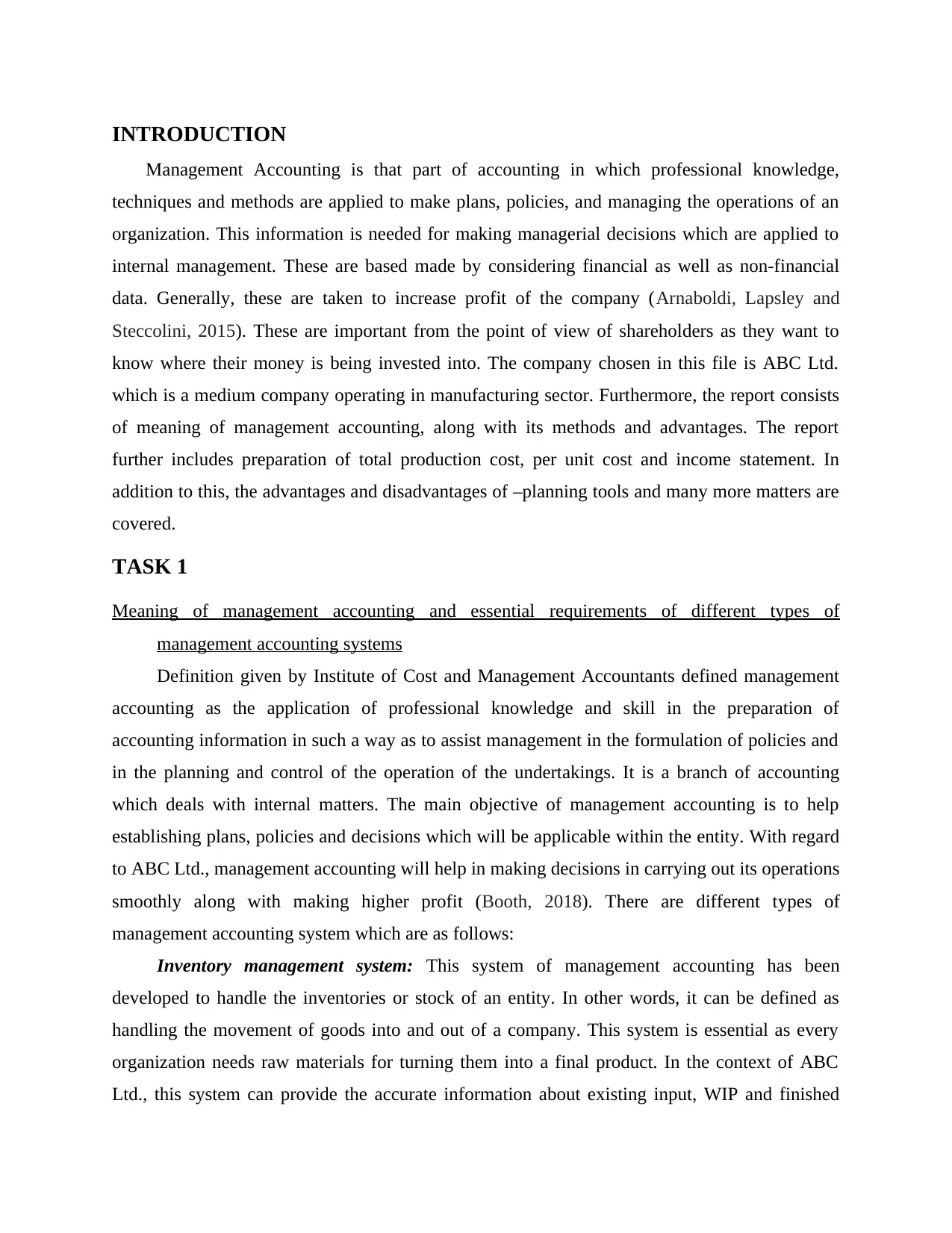
INTRODUCTION
Management Accounting is that part of accounting in which professional knowledge,
techniques and methods are applied to make plans, policies, and managing the operations of an
organization. This information is needed for making managerial decisions which are applied to
internal management. These are based made by considering financial as well as non-financial
data. Generally, these are taken to increase profit of the company (Arnaboldi, Lapsley and
Steccolini, 2015). These are important from the point of view of shareholders as they want to
know where their money is being invested into. The company chosen in this file is ABC Ltd.
which is a medium company operating in manufacturing sector. Furthermore, the report consists
of meaning of management accounting, along with its methods and advantages. The report
further includes preparation of total production cost, per unit cost and income statement. In
addition to this, the advantages and disadvantages of –planning tools and many more matters are
covered.
TASK 1
Meaning of management accounting and essential requirements of different types of
management accounting systems
Definition given by Institute of Cost and Management Accountants defined management
accounting as the application of professional knowledge and skill in the preparation of
accounting information in such a way as to assist management in the formulation of policies and
in the planning and control of the operation of the undertakings. It is a branch of accounting
which deals with internal matters. The main objective of management accounting is to help
establishing plans, policies and decisions which will be applicable within the entity. With regard
to ABC Ltd., management accounting will help in making decisions in carrying out its operations
smoothly along with making higher profit (Booth, 2018). There are different types of
management accounting system which are as follows:
Inventory management system: This system of management accounting has been
developed to handle the inventories or stock of an entity. In other words, it can be defined as
handling the movement of goods into and out of a company. This system is essential as every
organization needs raw materials for turning them into a final product. In the context of ABC
Ltd., this system can provide the accurate information about existing input, WIP and finished
Management Accounting is that part of accounting in which professional knowledge,
techniques and methods are applied to make plans, policies, and managing the operations of an
organization. This information is needed for making managerial decisions which are applied to
internal management. These are based made by considering financial as well as non-financial
data. Generally, these are taken to increase profit of the company (Arnaboldi, Lapsley and
Steccolini, 2015). These are important from the point of view of shareholders as they want to
know where their money is being invested into. The company chosen in this file is ABC Ltd.
which is a medium company operating in manufacturing sector. Furthermore, the report consists
of meaning of management accounting, along with its methods and advantages. The report
further includes preparation of total production cost, per unit cost and income statement. In
addition to this, the advantages and disadvantages of –planning tools and many more matters are
covered.
TASK 1
Meaning of management accounting and essential requirements of different types of
management accounting systems
Definition given by Institute of Cost and Management Accountants defined management
accounting as the application of professional knowledge and skill in the preparation of
accounting information in such a way as to assist management in the formulation of policies and
in the planning and control of the operation of the undertakings. It is a branch of accounting
which deals with internal matters. The main objective of management accounting is to help
establishing plans, policies and decisions which will be applicable within the entity. With regard
to ABC Ltd., management accounting will help in making decisions in carrying out its operations
smoothly along with making higher profit (Booth, 2018). There are different types of
management accounting system which are as follows:
Inventory management system: This system of management accounting has been
developed to handle the inventories or stock of an entity. In other words, it can be defined as
handling the movement of goods into and out of a company. This system is essential as every
organization needs raw materials for turning them into a final product. In the context of ABC
Ltd., this system can provide the accurate information about existing input, WIP and finished
⊘ This is a preview!⊘
Do you want full access?
Subscribe today to unlock all pages.

Trusted by 1+ million students worldwide
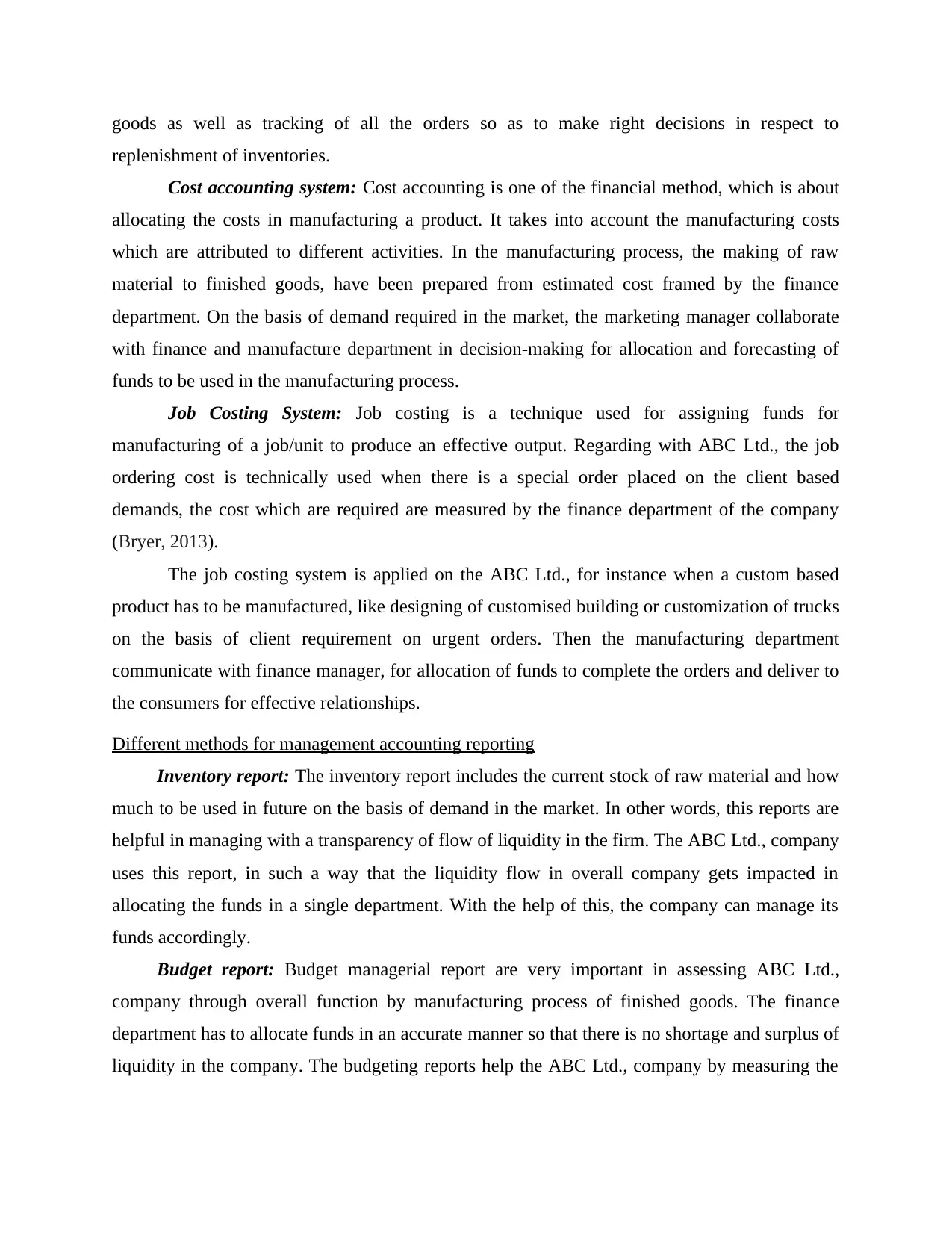
goods as well as tracking of all the orders so as to make right decisions in respect to
replenishment of inventories.
Cost accounting system: Cost accounting is one of the financial method, which is about
allocating the costs in manufacturing a product. It takes into account the manufacturing costs
which are attributed to different activities. In the manufacturing process, the making of raw
material to finished goods, have been prepared from estimated cost framed by the finance
department. On the basis of demand required in the market, the marketing manager collaborate
with finance and manufacture department in decision-making for allocation and forecasting of
funds to be used in the manufacturing process.
Job Costing System: Job costing is a technique used for assigning funds for
manufacturing of a job/unit to produce an effective output. Regarding with ABC Ltd., the job
ordering cost is technically used when there is a special order placed on the client based
demands, the cost which are required are measured by the finance department of the company
(Bryer, 2013).
The job costing system is applied on the ABC Ltd., for instance when a custom based
product has to be manufactured, like designing of customised building or customization of trucks
on the basis of client requirement on urgent orders. Then the manufacturing department
communicate with finance manager, for allocation of funds to complete the orders and deliver to
the consumers for effective relationships.
Different methods for management accounting reporting
Inventory report: The inventory report includes the current stock of raw material and how
much to be used in future on the basis of demand in the market. In other words, this reports are
helpful in managing with a transparency of flow of liquidity in the firm. The ABC Ltd., company
uses this report, in such a way that the liquidity flow in overall company gets impacted in
allocating the funds in a single department. With the help of this, the company can manage its
funds accordingly.
Budget report: Budget managerial report are very important in assessing ABC Ltd.,
company through overall function by manufacturing process of finished goods. The finance
department has to allocate funds in an accurate manner so that there is no shortage and surplus of
liquidity in the company. The budgeting reports help the ABC Ltd., company by measuring the
replenishment of inventories.
Cost accounting system: Cost accounting is one of the financial method, which is about
allocating the costs in manufacturing a product. It takes into account the manufacturing costs
which are attributed to different activities. In the manufacturing process, the making of raw
material to finished goods, have been prepared from estimated cost framed by the finance
department. On the basis of demand required in the market, the marketing manager collaborate
with finance and manufacture department in decision-making for allocation and forecasting of
funds to be used in the manufacturing process.
Job Costing System: Job costing is a technique used for assigning funds for
manufacturing of a job/unit to produce an effective output. Regarding with ABC Ltd., the job
ordering cost is technically used when there is a special order placed on the client based
demands, the cost which are required are measured by the finance department of the company
(Bryer, 2013).
The job costing system is applied on the ABC Ltd., for instance when a custom based
product has to be manufactured, like designing of customised building or customization of trucks
on the basis of client requirement on urgent orders. Then the manufacturing department
communicate with finance manager, for allocation of funds to complete the orders and deliver to
the consumers for effective relationships.
Different methods for management accounting reporting
Inventory report: The inventory report includes the current stock of raw material and how
much to be used in future on the basis of demand in the market. In other words, this reports are
helpful in managing with a transparency of flow of liquidity in the firm. The ABC Ltd., company
uses this report, in such a way that the liquidity flow in overall company gets impacted in
allocating the funds in a single department. With the help of this, the company can manage its
funds accordingly.
Budget report: Budget managerial report are very important in assessing ABC Ltd.,
company through overall function by manufacturing process of finished goods. The finance
department has to allocate funds in an accurate manner so that there is no shortage and surplus of
liquidity in the company. The budgeting reports help the ABC Ltd., company by measuring the
Paraphrase This Document
Need a fresh take? Get an instant paraphrase of this document with our AI Paraphraser
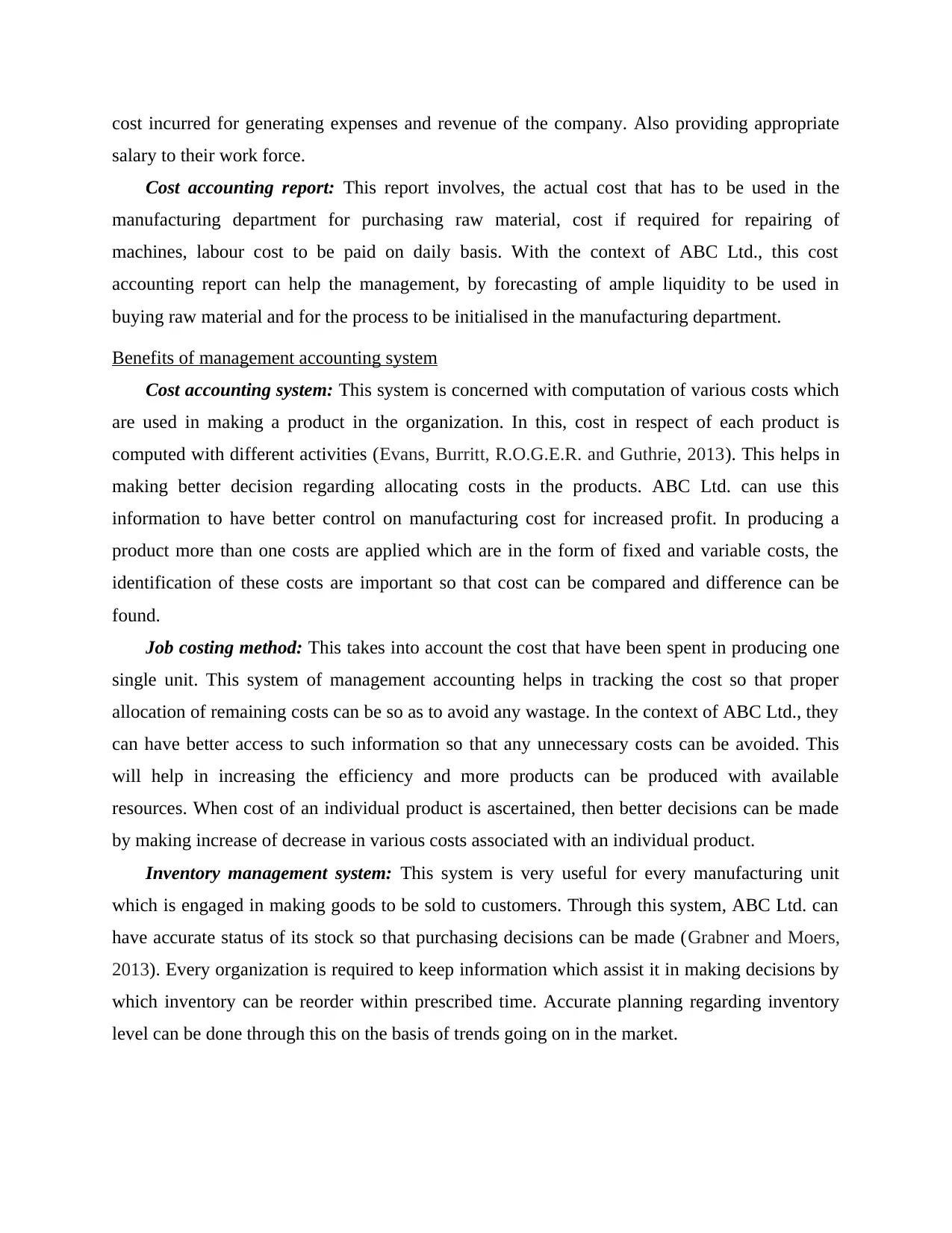
cost incurred for generating expenses and revenue of the company. Also providing appropriate
salary to their work force.
Cost accounting report: This report involves, the actual cost that has to be used in the
manufacturing department for purchasing raw material, cost if required for repairing of
machines, labour cost to be paid on daily basis. With the context of ABC Ltd., this cost
accounting report can help the management, by forecasting of ample liquidity to be used in
buying raw material and for the process to be initialised in the manufacturing department.
Benefits of management accounting system
Cost accounting system: This system is concerned with computation of various costs which
are used in making a product in the organization. In this, cost in respect of each product is
computed with different activities (Evans, Burritt, R.O.G.E.R. and Guthrie, 2013). This helps in
making better decision regarding allocating costs in the products. ABC Ltd. can use this
information to have better control on manufacturing cost for increased profit. In producing a
product more than one costs are applied which are in the form of fixed and variable costs, the
identification of these costs are important so that cost can be compared and difference can be
found.
Job costing method: This takes into account the cost that have been spent in producing one
single unit. This system of management accounting helps in tracking the cost so that proper
allocation of remaining costs can be so as to avoid any wastage. In the context of ABC Ltd., they
can have better access to such information so that any unnecessary costs can be avoided. This
will help in increasing the efficiency and more products can be produced with available
resources. When cost of an individual product is ascertained, then better decisions can be made
by making increase of decrease in various costs associated with an individual product.
Inventory management system: This system is very useful for every manufacturing unit
which is engaged in making goods to be sold to customers. Through this system, ABC Ltd. can
have accurate status of its stock so that purchasing decisions can be made (Grabner and Moers,
2013). Every organization is required to keep information which assist it in making decisions by
which inventory can be reorder within prescribed time. Accurate planning regarding inventory
level can be done through this on the basis of trends going on in the market.
salary to their work force.
Cost accounting report: This report involves, the actual cost that has to be used in the
manufacturing department for purchasing raw material, cost if required for repairing of
machines, labour cost to be paid on daily basis. With the context of ABC Ltd., this cost
accounting report can help the management, by forecasting of ample liquidity to be used in
buying raw material and for the process to be initialised in the manufacturing department.
Benefits of management accounting system
Cost accounting system: This system is concerned with computation of various costs which
are used in making a product in the organization. In this, cost in respect of each product is
computed with different activities (Evans, Burritt, R.O.G.E.R. and Guthrie, 2013). This helps in
making better decision regarding allocating costs in the products. ABC Ltd. can use this
information to have better control on manufacturing cost for increased profit. In producing a
product more than one costs are applied which are in the form of fixed and variable costs, the
identification of these costs are important so that cost can be compared and difference can be
found.
Job costing method: This takes into account the cost that have been spent in producing one
single unit. This system of management accounting helps in tracking the cost so that proper
allocation of remaining costs can be so as to avoid any wastage. In the context of ABC Ltd., they
can have better access to such information so that any unnecessary costs can be avoided. This
will help in increasing the efficiency and more products can be produced with available
resources. When cost of an individual product is ascertained, then better decisions can be made
by making increase of decrease in various costs associated with an individual product.
Inventory management system: This system is very useful for every manufacturing unit
which is engaged in making goods to be sold to customers. Through this system, ABC Ltd. can
have accurate status of its stock so that purchasing decisions can be made (Grabner and Moers,
2013). Every organization is required to keep information which assist it in making decisions by
which inventory can be reorder within prescribed time. Accurate planning regarding inventory
level can be done through this on the basis of trends going on in the market.
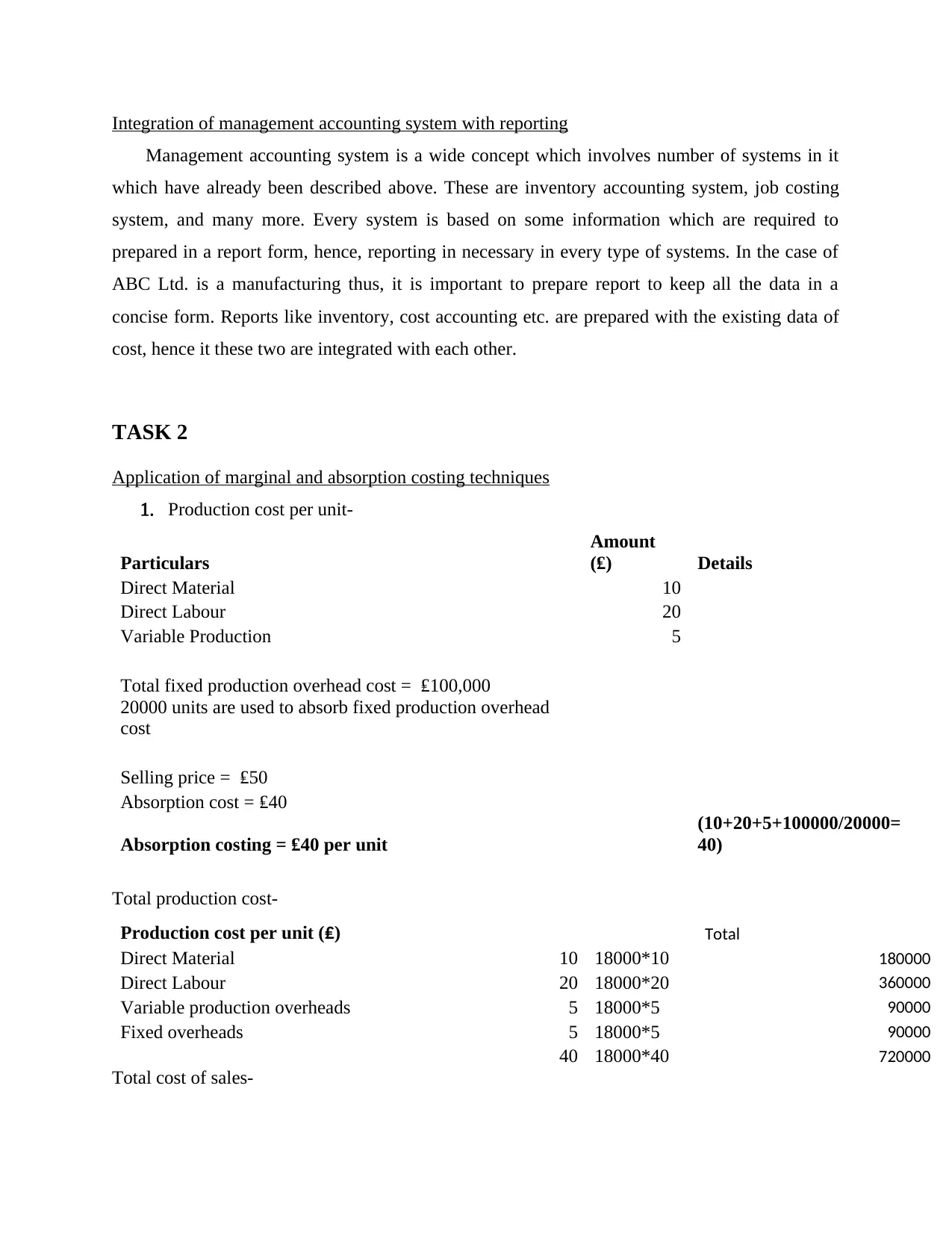
Integration of management accounting system with reporting
Management accounting system is a wide concept which involves number of systems in it
which have already been described above. These are inventory accounting system, job costing
system, and many more. Every system is based on some information which are required to
prepared in a report form, hence, reporting in necessary in every type of systems. In the case of
ABC Ltd. is a manufacturing thus, it is important to prepare report to keep all the data in a
concise form. Reports like inventory, cost accounting etc. are prepared with the existing data of
cost, hence it these two are integrated with each other.
TASK 2
Application of marginal and absorption costing techniques
1. Production cost per unit-
Particulars
Amount
(₤) Details
Direct Material 10
Direct Labour 20
Variable Production 5
Total fixed production overhead cost = ₤100,000
20000 units are used to absorb fixed production overhead
cost
Selling price = ₤50
Absorption cost = ₤40
Absorption costing = ₤40 per unit
(10+20+5+100000/20000=
40)
Total production cost-
Production cost per unit (₤) Total
Direct Material 10 18000*10 180000
Direct Labour 20 18000*20 360000
Variable production overheads 5 18000*5 90000
Fixed overheads 5 18000*5 90000
40 18000*40 720000
Total cost of sales-
Management accounting system is a wide concept which involves number of systems in it
which have already been described above. These are inventory accounting system, job costing
system, and many more. Every system is based on some information which are required to
prepared in a report form, hence, reporting in necessary in every type of systems. In the case of
ABC Ltd. is a manufacturing thus, it is important to prepare report to keep all the data in a
concise form. Reports like inventory, cost accounting etc. are prepared with the existing data of
cost, hence it these two are integrated with each other.
TASK 2
Application of marginal and absorption costing techniques
1. Production cost per unit-
Particulars
Amount
(₤) Details
Direct Material 10
Direct Labour 20
Variable Production 5
Total fixed production overhead cost = ₤100,000
20000 units are used to absorb fixed production overhead
cost
Selling price = ₤50
Absorption cost = ₤40
Absorption costing = ₤40 per unit
(10+20+5+100000/20000=
40)
Total production cost-
Production cost per unit (₤) Total
Direct Material 10 18000*10 180000
Direct Labour 20 18000*20 360000
Variable production overheads 5 18000*5 90000
Fixed overheads 5 18000*5 90000
40 18000*40 720000
Total cost of sales-
⊘ This is a preview!⊘
Do you want full access?
Subscribe today to unlock all pages.

Trusted by 1+ million students worldwide
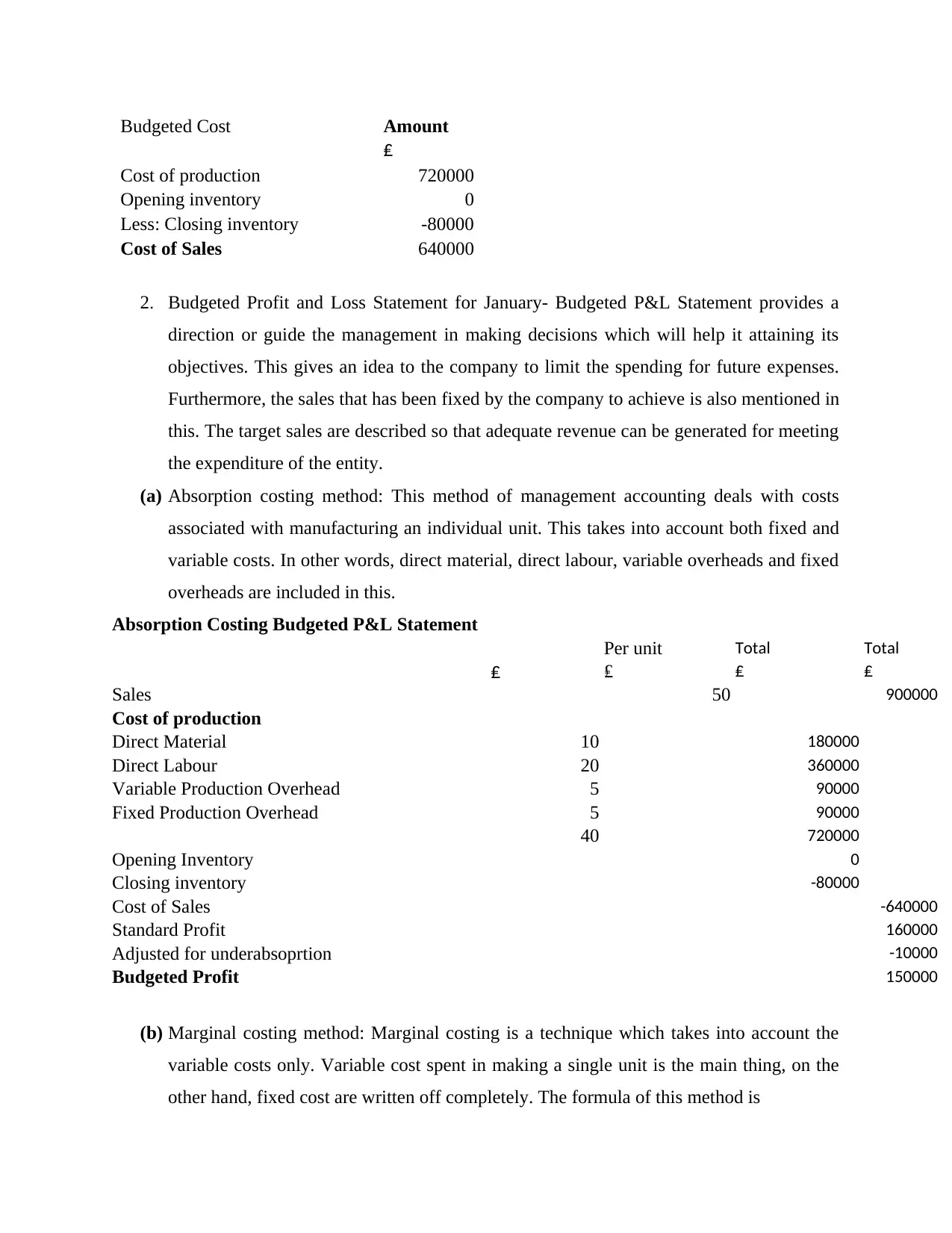
Budgeted Cost Amount
₤
Cost of production 720000
Opening inventory 0
Less: Closing inventory -80000
Cost of Sales 640000
2. Budgeted Profit and Loss Statement for January- Budgeted P&L Statement provides a
direction or guide the management in making decisions which will help it attaining its
objectives. This gives an idea to the company to limit the spending for future expenses.
Furthermore, the sales that has been fixed by the company to achieve is also mentioned in
this. The target sales are described so that adequate revenue can be generated for meeting
the expenditure of the entity.
(a) Absorption costing method: This method of management accounting deals with costs
associated with manufacturing an individual unit. This takes into account both fixed and
variable costs. In other words, direct material, direct labour, variable overheads and fixed
overheads are included in this.
Absorption Costing Budgeted P&L Statement
Per unit Total Total
₤ ₤ ₤ ₤
Sales 50 900000
Cost of production
Direct Material 10 180000
Direct Labour 20 360000
Variable Production Overhead 5 90000
Fixed Production Overhead 5 90000
40 720000
Opening Inventory 0
Closing inventory -80000
Cost of Sales -640000
Standard Profit 160000
Adjusted for underabsoprtion -10000
Budgeted Profit 150000
(b) Marginal costing method: Marginal costing is a technique which takes into account the
variable costs only. Variable cost spent in making a single unit is the main thing, on the
other hand, fixed cost are written off completely. The formula of this method is
₤
Cost of production 720000
Opening inventory 0
Less: Closing inventory -80000
Cost of Sales 640000
2. Budgeted Profit and Loss Statement for January- Budgeted P&L Statement provides a
direction or guide the management in making decisions which will help it attaining its
objectives. This gives an idea to the company to limit the spending for future expenses.
Furthermore, the sales that has been fixed by the company to achieve is also mentioned in
this. The target sales are described so that adequate revenue can be generated for meeting
the expenditure of the entity.
(a) Absorption costing method: This method of management accounting deals with costs
associated with manufacturing an individual unit. This takes into account both fixed and
variable costs. In other words, direct material, direct labour, variable overheads and fixed
overheads are included in this.
Absorption Costing Budgeted P&L Statement
Per unit Total Total
₤ ₤ ₤ ₤
Sales 50 900000
Cost of production
Direct Material 10 180000
Direct Labour 20 360000
Variable Production Overhead 5 90000
Fixed Production Overhead 5 90000
40 720000
Opening Inventory 0
Closing inventory -80000
Cost of Sales -640000
Standard Profit 160000
Adjusted for underabsoprtion -10000
Budgeted Profit 150000
(b) Marginal costing method: Marginal costing is a technique which takes into account the
variable costs only. Variable cost spent in making a single unit is the main thing, on the
other hand, fixed cost are written off completely. The formula of this method is
Paraphrase This Document
Need a fresh take? Get an instant paraphrase of this document with our AI Paraphraser
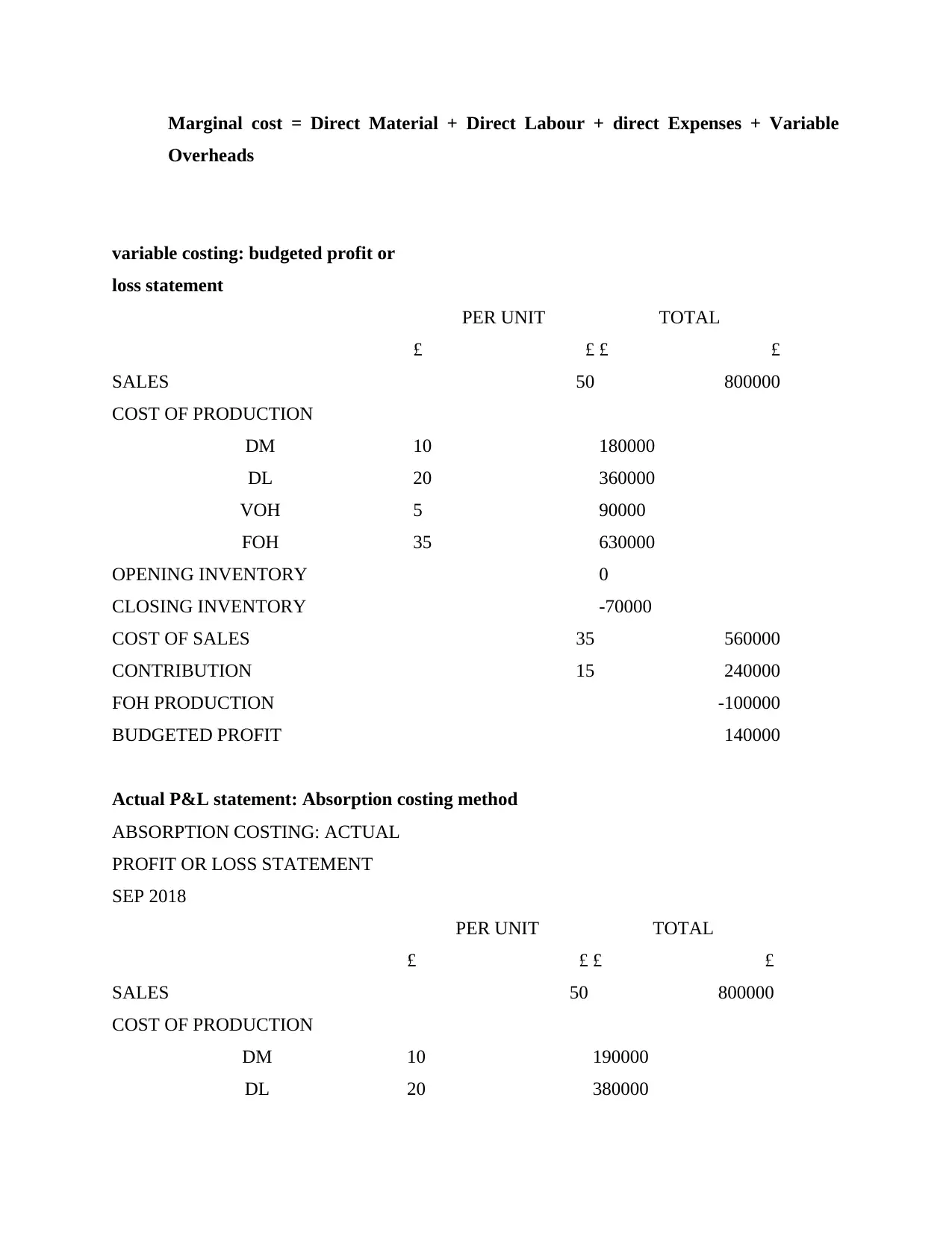
Marginal cost = Direct Material + Direct Labour + direct Expenses + Variable
Overheads
variable costing: budgeted profit or
loss statement
PER UNIT TOTAL
£ £ £ £
SALES 50 800000
COST OF PRODUCTION
DM 10 180000
DL 20 360000
VOH 5 90000
FOH 35 630000
OPENING INVENTORY 0
CLOSING INVENTORY -70000
COST OF SALES 35 560000
CONTRIBUTION 15 240000
FOH PRODUCTION -100000
BUDGETED PROFIT 140000
Actual P&L statement: Absorption costing method
ABSORPTION COSTING: ACTUAL
PROFIT OR LOSS STATEMENT
SEP 2018
PER UNIT TOTAL
£ £ £ £
SALES 50 800000
COST OF PRODUCTION
DM 10 190000
DL 20 380000
Overheads
variable costing: budgeted profit or
loss statement
PER UNIT TOTAL
£ £ £ £
SALES 50 800000
COST OF PRODUCTION
DM 10 180000
DL 20 360000
VOH 5 90000
FOH 35 630000
OPENING INVENTORY 0
CLOSING INVENTORY -70000
COST OF SALES 35 560000
CONTRIBUTION 15 240000
FOH PRODUCTION -100000
BUDGETED PROFIT 140000
Actual P&L statement: Absorption costing method
ABSORPTION COSTING: ACTUAL
PROFIT OR LOSS STATEMENT
SEP 2018
PER UNIT TOTAL
£ £ £ £
SALES 50 800000
COST OF PRODUCTION
DM 10 190000
DL 20 380000
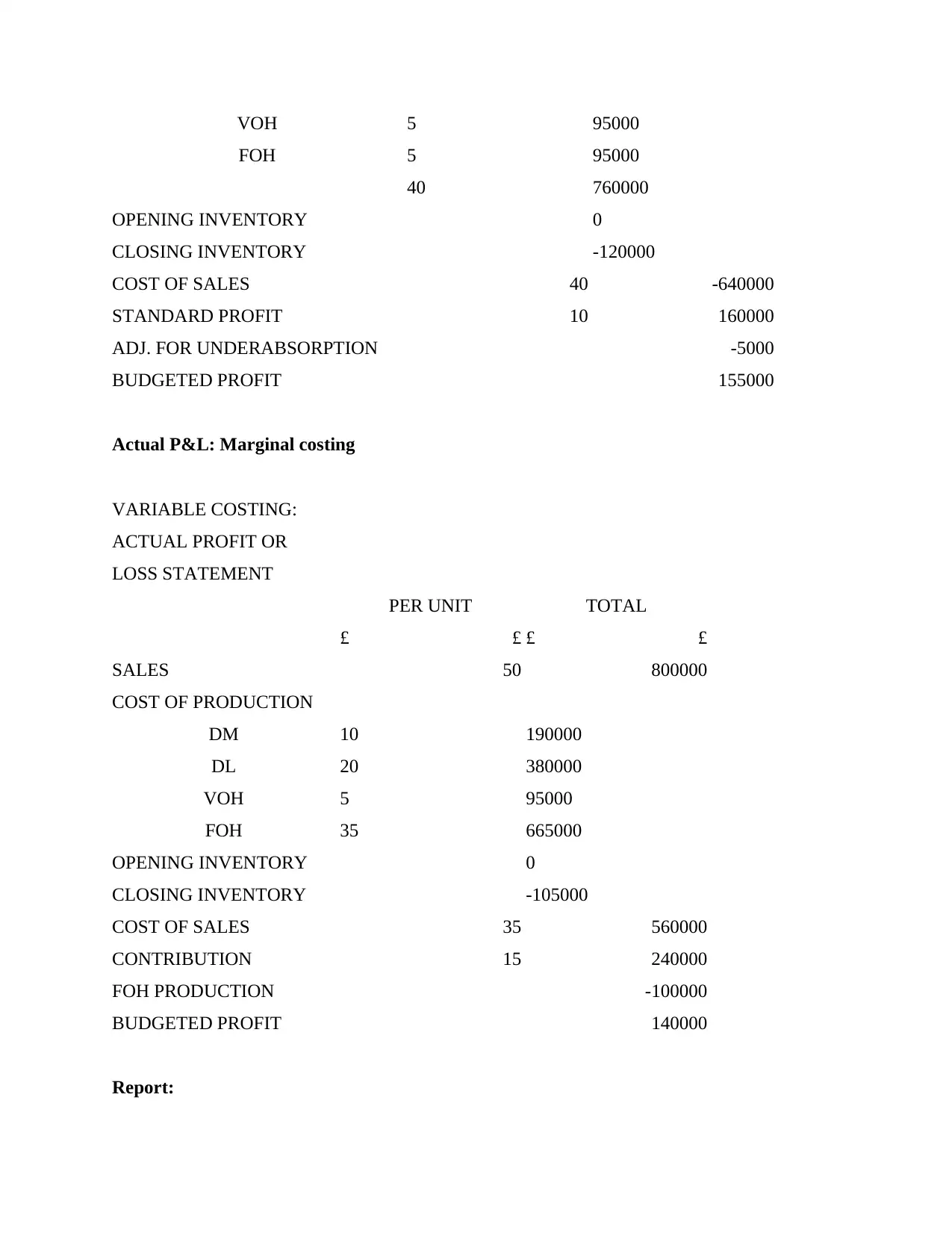
VOH 5 95000
FOH 5 95000
40 760000
OPENING INVENTORY 0
CLOSING INVENTORY -120000
COST OF SALES 40 -640000
STANDARD PROFIT 10 160000
ADJ. FOR UNDERABSORPTION -5000
BUDGETED PROFIT 155000
Actual P&L: Marginal costing
VARIABLE COSTING:
ACTUAL PROFIT OR
LOSS STATEMENT
PER UNIT TOTAL
£ £ £ £
SALES 50 800000
COST OF PRODUCTION
DM 10 190000
DL 20 380000
VOH 5 95000
FOH 35 665000
OPENING INVENTORY 0
CLOSING INVENTORY -105000
COST OF SALES 35 560000
CONTRIBUTION 15 240000
FOH PRODUCTION -100000
BUDGETED PROFIT 140000
Report:
FOH 5 95000
40 760000
OPENING INVENTORY 0
CLOSING INVENTORY -120000
COST OF SALES 40 -640000
STANDARD PROFIT 10 160000
ADJ. FOR UNDERABSORPTION -5000
BUDGETED PROFIT 155000
Actual P&L: Marginal costing
VARIABLE COSTING:
ACTUAL PROFIT OR
LOSS STATEMENT
PER UNIT TOTAL
£ £ £ £
SALES 50 800000
COST OF PRODUCTION
DM 10 190000
DL 20 380000
VOH 5 95000
FOH 35 665000
OPENING INVENTORY 0
CLOSING INVENTORY -105000
COST OF SALES 35 560000
CONTRIBUTION 15 240000
FOH PRODUCTION -100000
BUDGETED PROFIT 140000
Report:
⊘ This is a preview!⊘
Do you want full access?
Subscribe today to unlock all pages.

Trusted by 1+ million students worldwide
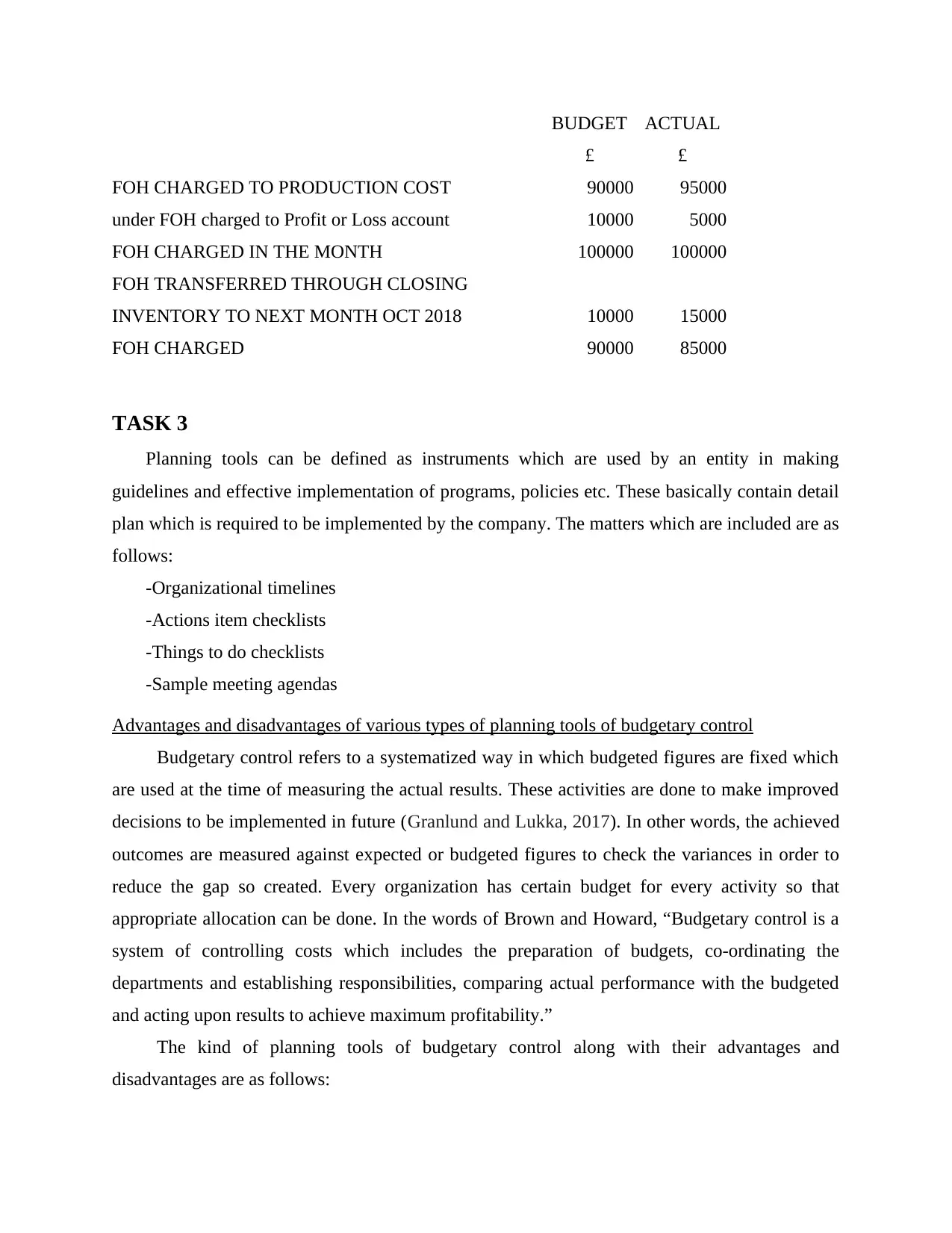
BUDGET ACTUAL
£ £
FOH CHARGED TO PRODUCTION COST 90000 95000
under FOH charged to Profit or Loss account 10000 5000
FOH CHARGED IN THE MONTH 100000 100000
FOH TRANSFERRED THROUGH CLOSING
INVENTORY TO NEXT MONTH OCT 2018 10000 15000
FOH CHARGED 90000 85000
TASK 3
Planning tools can be defined as instruments which are used by an entity in making
guidelines and effective implementation of programs, policies etc. These basically contain detail
plan which is required to be implemented by the company. The matters which are included are as
follows:
-Organizational timelines
-Actions item checklists
-Things to do checklists
-Sample meeting agendas
Advantages and disadvantages of various types of planning tools of budgetary control
Budgetary control refers to a systematized way in which budgeted figures are fixed which
are used at the time of measuring the actual results. These activities are done to make improved
decisions to be implemented in future (Granlund and Lukka, 2017). In other words, the achieved
outcomes are measured against expected or budgeted figures to check the variances in order to
reduce the gap so created. Every organization has certain budget for every activity so that
appropriate allocation can be done. In the words of Brown and Howard, “Budgetary control is a
system of controlling costs which includes the preparation of budgets, co-ordinating the
departments and establishing responsibilities, comparing actual performance with the budgeted
and acting upon results to achieve maximum profitability.”
The kind of planning tools of budgetary control along with their advantages and
disadvantages are as follows:
£ £
FOH CHARGED TO PRODUCTION COST 90000 95000
under FOH charged to Profit or Loss account 10000 5000
FOH CHARGED IN THE MONTH 100000 100000
FOH TRANSFERRED THROUGH CLOSING
INVENTORY TO NEXT MONTH OCT 2018 10000 15000
FOH CHARGED 90000 85000
TASK 3
Planning tools can be defined as instruments which are used by an entity in making
guidelines and effective implementation of programs, policies etc. These basically contain detail
plan which is required to be implemented by the company. The matters which are included are as
follows:
-Organizational timelines
-Actions item checklists
-Things to do checklists
-Sample meeting agendas
Advantages and disadvantages of various types of planning tools of budgetary control
Budgetary control refers to a systematized way in which budgeted figures are fixed which
are used at the time of measuring the actual results. These activities are done to make improved
decisions to be implemented in future (Granlund and Lukka, 2017). In other words, the achieved
outcomes are measured against expected or budgeted figures to check the variances in order to
reduce the gap so created. Every organization has certain budget for every activity so that
appropriate allocation can be done. In the words of Brown and Howard, “Budgetary control is a
system of controlling costs which includes the preparation of budgets, co-ordinating the
departments and establishing responsibilities, comparing actual performance with the budgeted
and acting upon results to achieve maximum profitability.”
The kind of planning tools of budgetary control along with their advantages and
disadvantages are as follows:
Paraphrase This Document
Need a fresh take? Get an instant paraphrase of this document with our AI Paraphraser
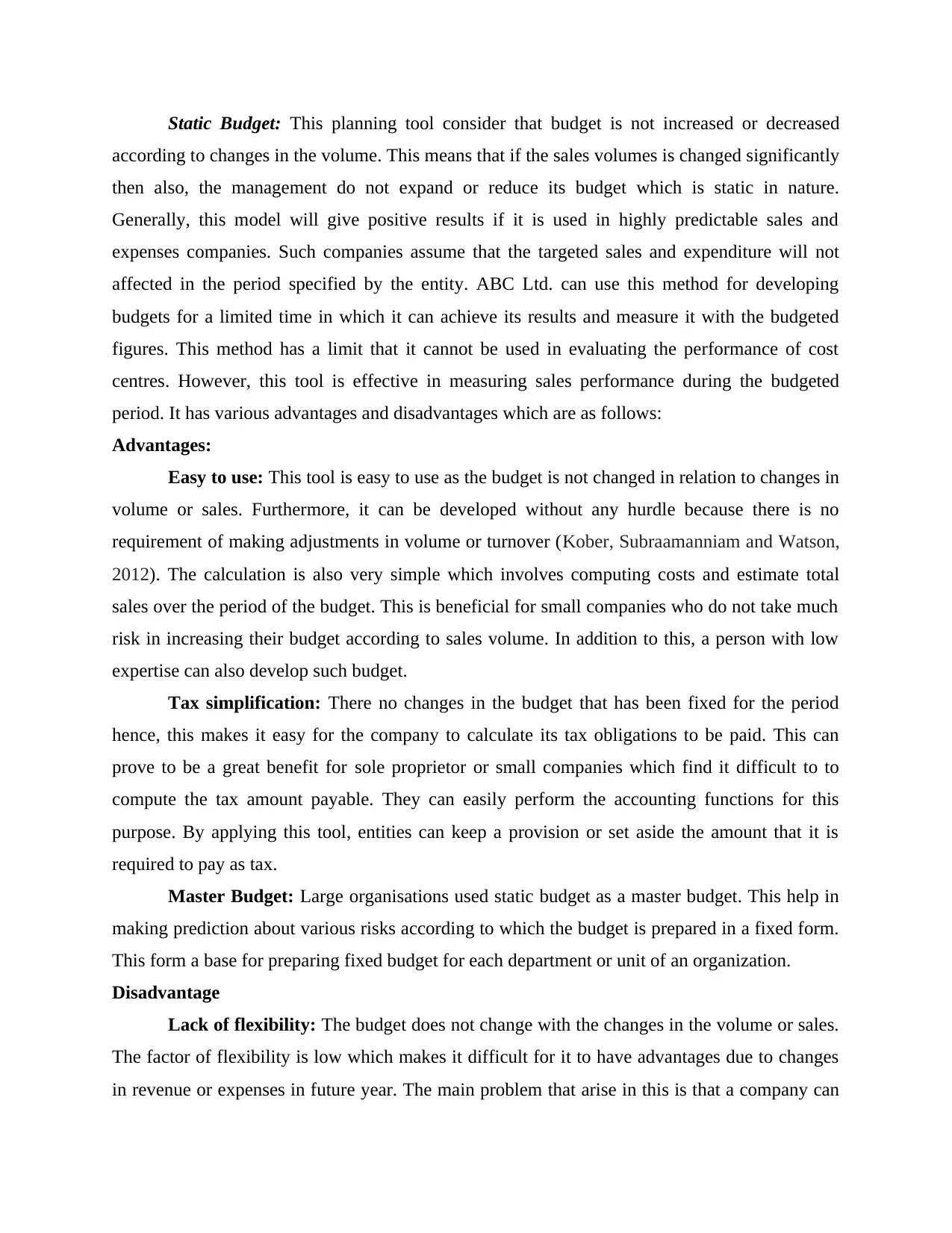
Static Budget: This planning tool consider that budget is not increased or decreased
according to changes in the volume. This means that if the sales volumes is changed significantly
then also, the management do not expand or reduce its budget which is static in nature.
Generally, this model will give positive results if it is used in highly predictable sales and
expenses companies. Such companies assume that the targeted sales and expenditure will not
affected in the period specified by the entity. ABC Ltd. can use this method for developing
budgets for a limited time in which it can achieve its results and measure it with the budgeted
figures. This method has a limit that it cannot be used in evaluating the performance of cost
centres. However, this tool is effective in measuring sales performance during the budgeted
period. It has various advantages and disadvantages which are as follows:
Advantages:
Easy to use: This tool is easy to use as the budget is not changed in relation to changes in
volume or sales. Furthermore, it can be developed without any hurdle because there is no
requirement of making adjustments in volume or turnover (Kober, Subraamanniam and Watson,
2012). The calculation is also very simple which involves computing costs and estimate total
sales over the period of the budget. This is beneficial for small companies who do not take much
risk in increasing their budget according to sales volume. In addition to this, a person with low
expertise can also develop such budget.
Tax simplification: There no changes in the budget that has been fixed for the period
hence, this makes it easy for the company to calculate its tax obligations to be paid. This can
prove to be a great benefit for sole proprietor or small companies which find it difficult to to
compute the tax amount payable. They can easily perform the accounting functions for this
purpose. By applying this tool, entities can keep a provision or set aside the amount that it is
required to pay as tax.
Master Budget: Large organisations used static budget as a master budget. This help in
making prediction about various risks according to which the budget is prepared in a fixed form.
This form a base for preparing fixed budget for each department or unit of an organization.
Disadvantage
Lack of flexibility: The budget does not change with the changes in the volume or sales.
The factor of flexibility is low which makes it difficult for it to have advantages due to changes
in revenue or expenses in future year. The main problem that arise in this is that a company can
according to changes in the volume. This means that if the sales volumes is changed significantly
then also, the management do not expand or reduce its budget which is static in nature.
Generally, this model will give positive results if it is used in highly predictable sales and
expenses companies. Such companies assume that the targeted sales and expenditure will not
affected in the period specified by the entity. ABC Ltd. can use this method for developing
budgets for a limited time in which it can achieve its results and measure it with the budgeted
figures. This method has a limit that it cannot be used in evaluating the performance of cost
centres. However, this tool is effective in measuring sales performance during the budgeted
period. It has various advantages and disadvantages which are as follows:
Advantages:
Easy to use: This tool is easy to use as the budget is not changed in relation to changes in
volume or sales. Furthermore, it can be developed without any hurdle because there is no
requirement of making adjustments in volume or turnover (Kober, Subraamanniam and Watson,
2012). The calculation is also very simple which involves computing costs and estimate total
sales over the period of the budget. This is beneficial for small companies who do not take much
risk in increasing their budget according to sales volume. In addition to this, a person with low
expertise can also develop such budget.
Tax simplification: There no changes in the budget that has been fixed for the period
hence, this makes it easy for the company to calculate its tax obligations to be paid. This can
prove to be a great benefit for sole proprietor or small companies which find it difficult to to
compute the tax amount payable. They can easily perform the accounting functions for this
purpose. By applying this tool, entities can keep a provision or set aside the amount that it is
required to pay as tax.
Master Budget: Large organisations used static budget as a master budget. This help in
making prediction about various risks according to which the budget is prepared in a fixed form.
This form a base for preparing fixed budget for each department or unit of an organization.
Disadvantage
Lack of flexibility: The budget does not change with the changes in the volume or sales.
The factor of flexibility is low which makes it difficult for it to have advantages due to changes
in revenue or expenses in future year. The main problem that arise in this is that a company can
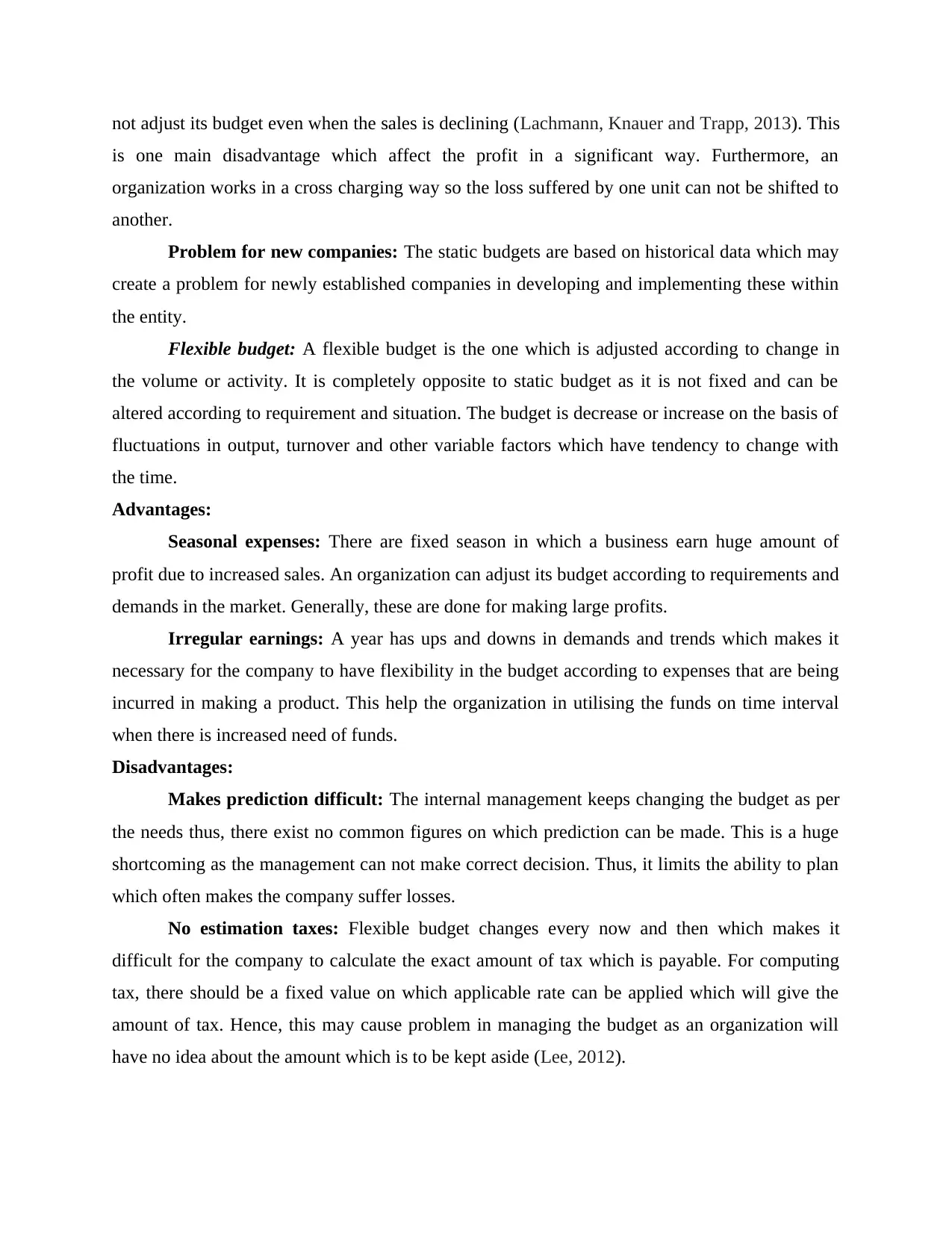
not adjust its budget even when the sales is declining (Lachmann, Knauer and Trapp, 2013). This
is one main disadvantage which affect the profit in a significant way. Furthermore, an
organization works in a cross charging way so the loss suffered by one unit can not be shifted to
another.
Problem for new companies: The static budgets are based on historical data which may
create a problem for newly established companies in developing and implementing these within
the entity.
Flexible budget: A flexible budget is the one which is adjusted according to change in
the volume or activity. It is completely opposite to static budget as it is not fixed and can be
altered according to requirement and situation. The budget is decrease or increase on the basis of
fluctuations in output, turnover and other variable factors which have tendency to change with
the time.
Advantages:
Seasonal expenses: There are fixed season in which a business earn huge amount of
profit due to increased sales. An organization can adjust its budget according to requirements and
demands in the market. Generally, these are done for making large profits.
Irregular earnings: A year has ups and downs in demands and trends which makes it
necessary for the company to have flexibility in the budget according to expenses that are being
incurred in making a product. This help the organization in utilising the funds on time interval
when there is increased need of funds.
Disadvantages:
Makes prediction difficult: The internal management keeps changing the budget as per
the needs thus, there exist no common figures on which prediction can be made. This is a huge
shortcoming as the management can not make correct decision. Thus, it limits the ability to plan
which often makes the company suffer losses.
No estimation taxes: Flexible budget changes every now and then which makes it
difficult for the company to calculate the exact amount of tax which is payable. For computing
tax, there should be a fixed value on which applicable rate can be applied which will give the
amount of tax. Hence, this may cause problem in managing the budget as an organization will
have no idea about the amount which is to be kept aside (Lee, 2012).
is one main disadvantage which affect the profit in a significant way. Furthermore, an
organization works in a cross charging way so the loss suffered by one unit can not be shifted to
another.
Problem for new companies: The static budgets are based on historical data which may
create a problem for newly established companies in developing and implementing these within
the entity.
Flexible budget: A flexible budget is the one which is adjusted according to change in
the volume or activity. It is completely opposite to static budget as it is not fixed and can be
altered according to requirement and situation. The budget is decrease or increase on the basis of
fluctuations in output, turnover and other variable factors which have tendency to change with
the time.
Advantages:
Seasonal expenses: There are fixed season in which a business earn huge amount of
profit due to increased sales. An organization can adjust its budget according to requirements and
demands in the market. Generally, these are done for making large profits.
Irregular earnings: A year has ups and downs in demands and trends which makes it
necessary for the company to have flexibility in the budget according to expenses that are being
incurred in making a product. This help the organization in utilising the funds on time interval
when there is increased need of funds.
Disadvantages:
Makes prediction difficult: The internal management keeps changing the budget as per
the needs thus, there exist no common figures on which prediction can be made. This is a huge
shortcoming as the management can not make correct decision. Thus, it limits the ability to plan
which often makes the company suffer losses.
No estimation taxes: Flexible budget changes every now and then which makes it
difficult for the company to calculate the exact amount of tax which is payable. For computing
tax, there should be a fixed value on which applicable rate can be applied which will give the
amount of tax. Hence, this may cause problem in managing the budget as an organization will
have no idea about the amount which is to be kept aside (Lee, 2012).
⊘ This is a preview!⊘
Do you want full access?
Subscribe today to unlock all pages.

Trusted by 1+ million students worldwide
1 out of 16
Related Documents
Your All-in-One AI-Powered Toolkit for Academic Success.
+13062052269
info@desklib.com
Available 24*7 on WhatsApp / Email
![[object Object]](/_next/static/media/star-bottom.7253800d.svg)
Unlock your academic potential
Copyright © 2020–2025 A2Z Services. All Rights Reserved. Developed and managed by ZUCOL.





